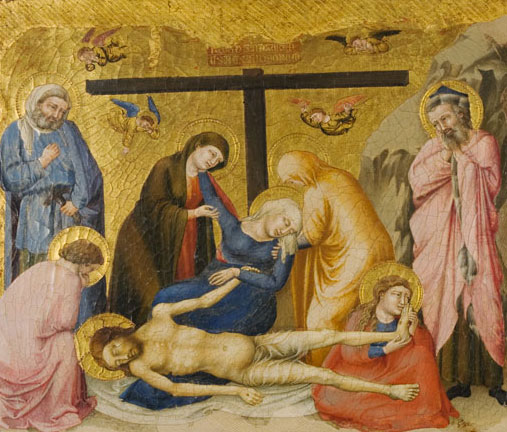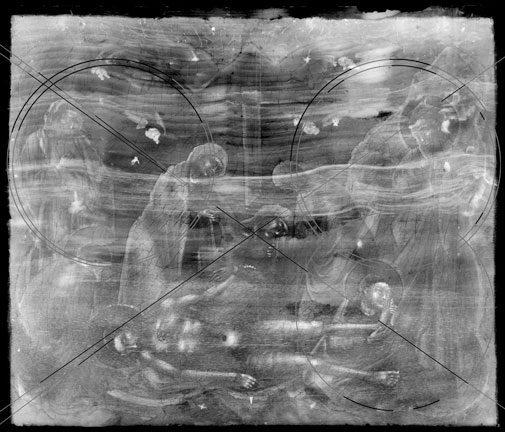On November 16, 1927, soon after the Fogg Museum celebrated the opening of its new home on Quincy Street, the museum’s leadership was marking another notable event: the centenary of Professor Charles Eliot Norton’s birth. Norton had been the first professor of art history in the United States. To mark this special day, Assistant Director Paul J. Sachs gave the museum an important painting depicting the Pietà, The Lamentation over the Dead Christ. The Fogg Museum’s 1927–28 annual report described it as “a beautiful little panel representing The Mourning over the Body of Christ, by an Italian fourteenth-century master, probably of the Florentine School.” This tempera and gold-covered painting has now become a key part of an international research project that led to the extraordinary construction of a new frame.
The Harvard Art Museums’ Lamentation over the Dead Christ is thought to be part of a much larger altarpiece attributed to a Tuscan or Umbrian artist whose name is associated with the Fogg Museum panel. Although little is known about the Master of the Fogg Pietà, he is considered a major early Renaissance painter. The Lamentation panel comes from the altarpiece’s base, or predella, as do two paintings found at London’s Courtauld Institute of Art, Saint Lawrence and A Bishop Saint; two other paintings from the predella are in a private collection. If all the pieces art historians have identified as belonging to the original work were brought together, the complete altarpiece would likely consist of more than a dozen panels, now located in institutions and private collections throughout the United States and Europe.
In 2008, Lauren Cox, a former Fellow in paintings conservation at the Straus Center for Conservation and Technical Studies, worked with Stephan Wolohojian, the Landon and Lavinia Clay Curator, paintings conservator Teri Hensick, and conservation scientist Narayan Khandekar as part of a collaborative research project with geographically disparate institutions, made possible by funding from the Andrew W. Mellon Foundation. Together with the Courtauld Institute in London, the Worcester Art Museum, Opificio delle pietre dure (Florence), and Instituut Collectie Nederland (Amsterdam), the Harvard Art Museums tested an online tool designed for the various institutions to share technical, archival, and art historical research related to their panels. From this information, the group began to map a reconstruction of the altarpiece based on a better understanding of the Master of the Fogg Pietà’s technique.
The researchers have shared x-radiographs of the various panels, which reveal important clues about the altarpiece’s original composition. Looking at the panels’ wood grain, for instance, has helped identify the original positions of the predella panels. X-ray images of the Harvard Art Museums’ Lamentation in particular brought to light unusual underlying incision lines that hint at where the painting’s original molding was once fixed.
Stay tuned next week, when we will consider how these discoveries informed the remarkable reframing of the Lamentation over the Dead Christ.





